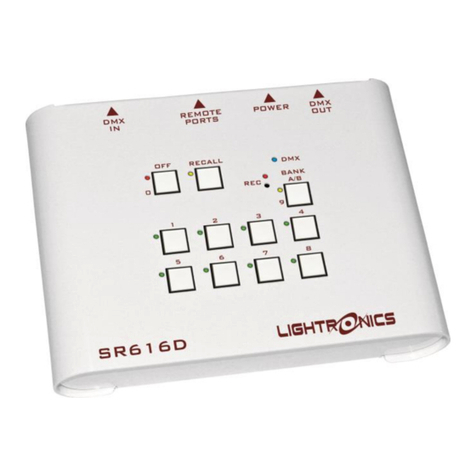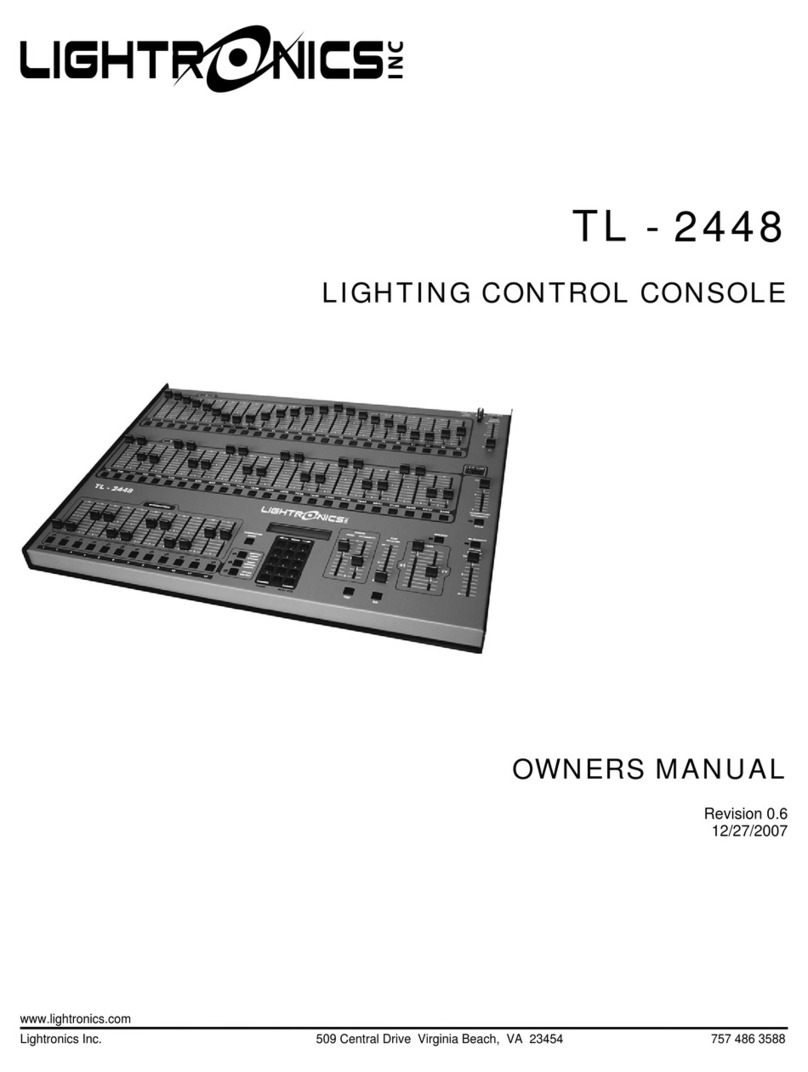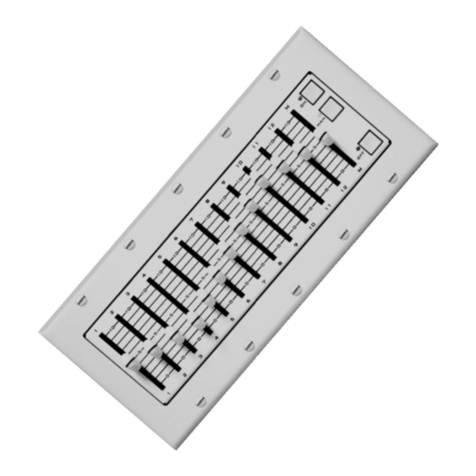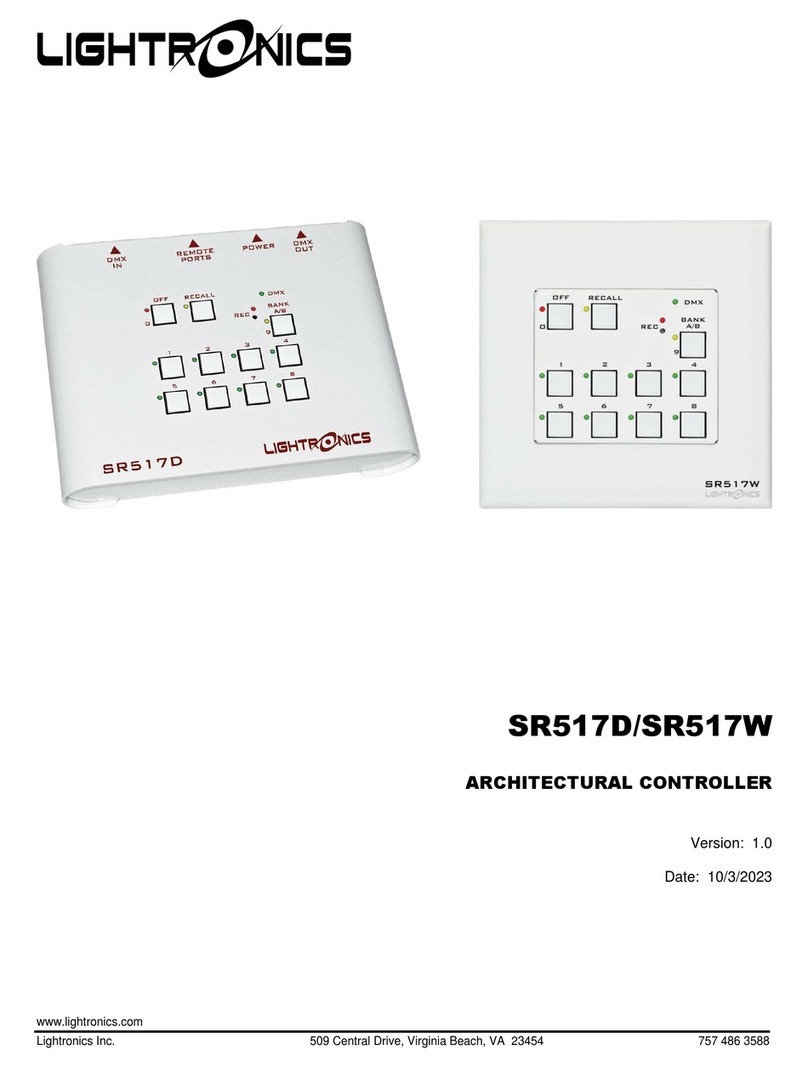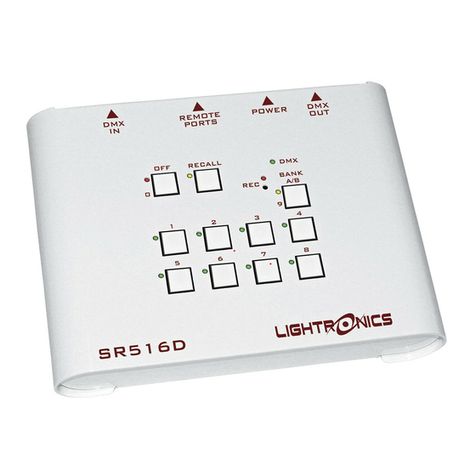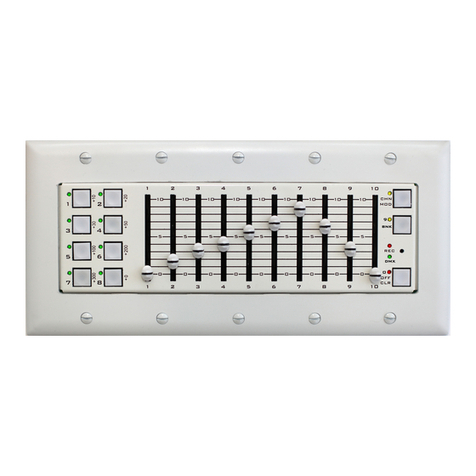
Page 2 of 3
AF5113 ARCHITECTURAL REMOTE STATION
Version 0.2 OWNER’S MANUAL 06/14/2023
www.lightronics.com
Lightronics Inc. 509 Central Drive, Virginia Beach, VA 23454 tell 757 486 3588
INTRODUCTION
The AF5113 is a 12 scene, wall mount remote station
which utilizes a standard five gang wall switch box. It is
intended for use with the Lightronics LitNet
architectural control system. The LitNet host units
consist of the AB ballast/LED drivers, the AR / RA
series of architectural dimmers, and the SR616 /
SC910 architectural controllers. All power and data
connections are via a four wire communication bus
between itself and the LitNet host.
The AF5113 provides manual fader control of 12
scenes. The 13th fader serves as a master control for
all twelve scene faders. Pushbutton switches are
provided to activate the manual faders, along with a
blackout and an “all full on” selection. LED indicators
provide status feedback.
Multiple units may be daisy chained together to provide
control from various locations. The AF5113 may also
be used with other Lightronics architectural remote
stations.
INSTALLATION
CONNECTIONS
The AF5113 connects to a LitNet host via a shielded
four conductor cable arranged as two twisted pairs. A
data grade, low capacitance cable (less than 25 pf/ft.)
is required. One pair connects to the DATA – and
DATA + signals. The other pair carries the power
(REMOTE V+) and COMMON. The cable shield
should be connected to the COMMON. A connection
diagram is provided at the end of this manual.
CONNECTING A SINGLE UNIT: Connect the four
cable wires to the screw down terminals on the back of
the unit. Connect the cable shield to the REMOTE
COMMON terminal. The other end of the cable will
connect to a LitNet host unit. See the LitNet host
product owner’s manual for exact connection details.
CONNECTING MULTIPLE UNITS: Follow the
instructions above for a single unit for the first AF5113.
Connect the corresponding connector pins of the
second unit to those of the first unit. Continue to daisy
chain additional remote stations to the second unit and
so forth.
MULTIPLE UNITS OF DIFFERENT TYPES: The
AF5113 may be connected together with other
Lightronics smart remotes. These remotes all have the
same connection scheme. Connect the AF5113 to the
other remotes by connecting like signal names
together (REMOTE COMMON to REMOTE COMMON
etc.).
SCENE ASSIGNMENTS
The AF5113 operates by fading scenes 51 thru 62 in
the AR / AB / RA units. The leftmost fader (#1)
corresponds to scene 51. Scene numbers proceed
from left to right. If multiple AF5113 units are used
together, then they will each operate scenes 51 - 62.
Scene assignments with the SR616 and SC910 host
units are specified within the owner’s manual of those
devices.
It is possible to have an AF5113 operate other scenes,
but the unit must be ordered with special programming.
OPERATION
No setup or turn on procedure is needed. When the
LitNet host unit is powered on, the AF5113 will also be
activated. The AF5113 will activate in the "all scenes
off" state.
The scenes activated by the AF5113 must be created
and stored in the LitNet host prior to activation. See
the LitNet host product owner’s manual for detailed
instructions for creating and storing scenes.
The faders on each AF5113 operate in a pile-on mode
on a "greatest of" basis. This means that the value for
a particular DMX address will be at the highest setting
of any scene calling for that DMX address.
If multiple AF stations will be installed in a system, any
action taken on one station will update the status of all
scenes to the settings on that particular station. The
faders on one unit do not physically move the faders
on other stations to match the new scene setting.
The MAN button enables the faders for raising and
lowering scenes.
The OFF button causes all twelve scenes to be
blacked out (turned off).
The ON button causes all twelve scenes to be fully
activated (turned on).
Remove all power from the LitNet
Host before making connections
